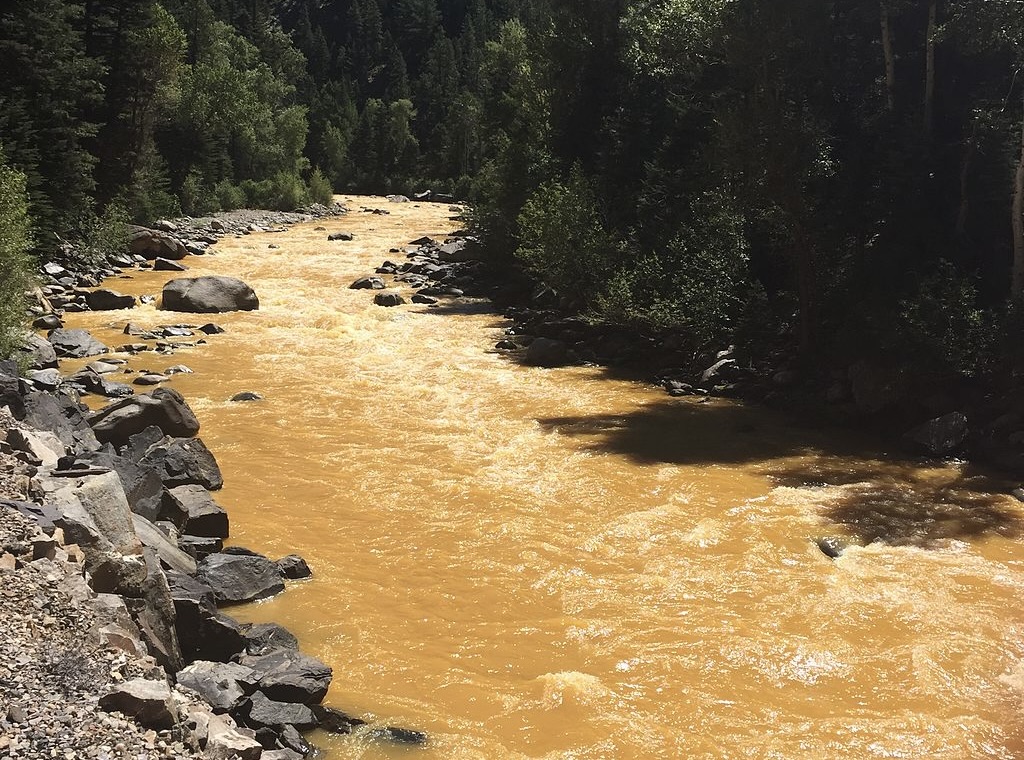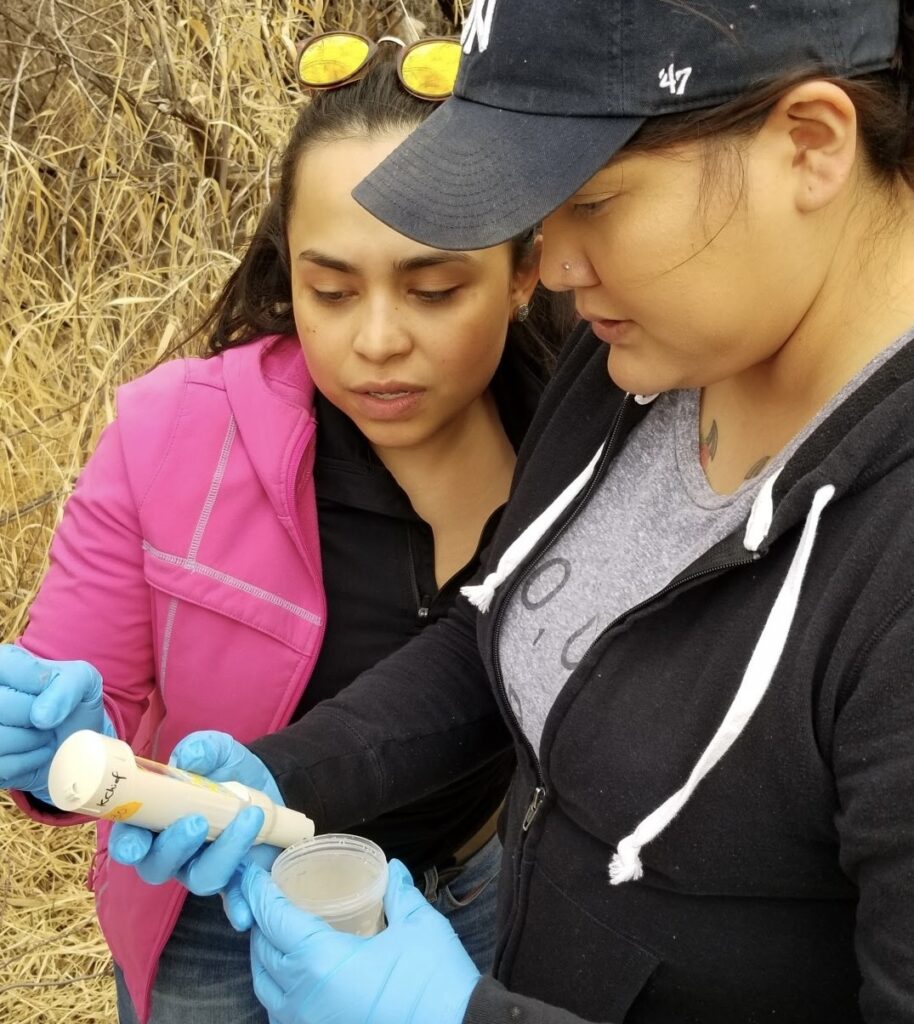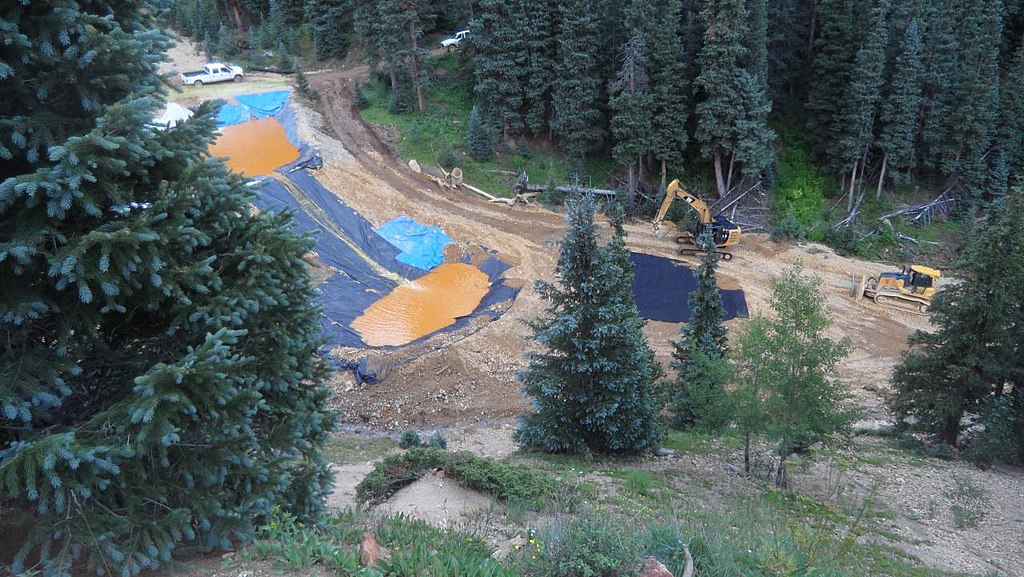When a river flowing through the Navajo Nation turned toxic from the 2015 Gold King Mine spill, scientists turned to tribal members for help. The resulting Diné Exposure Project is now being studied as a model of community engaged research.
By Melanie Lenart

Nearly nine years ago, the Gold King Mine made national headlines when a dam holding highly toxic tailings broke, spilling three million gallons of yellow sludge into the San Juan River, which flows through the Navajo Nation. Residents were quickly warned not to drink or bathe in the water as levels of lead, arsenic, cadmium and other heavy metals reached unsafe levels.
“It was chaos, I remember, and we were right in the middle of it,” recalled Neilroy Singer, an environmental scientist with Diné College’s Environmental Institute. Seeing the yellow water flow downstream into the San Juan River worried tribal members. “They were concerned right away about their life, their farming, their crops, their animals—is it safe?”
The community needed information they could trust, which meant that it had to come from people they could trust. Luckily for them, many Diné had moved into positions of leadership in academia and were happy to help.
Within two months of the August 2015 toxic release, scientists from Diné College, the University of Arizona and the University of New Mexico began devising a monitoring plan that would make tribal members active participants in the work of water testing. The citizen engagement and other aspects of the project is now being recognized as a powerful example of Indigenous research methodology in action.
An Indigenous approach to research
Yoshira Ornelas Van Horne, then a doctoral student with the University of Arizona, said that even before they found funding for the project, she and others started attending quarterly “listening sessions” with elders such as Charles Perry, the former director of the Diné College’s Environmental Institute.
“One of the bodies of work I ended up learning about was Diné philosophy, where it talks about how everything is interconnected,” Ornelas said. This helped her understand how traumatic the spill was to the Diné people. “This was really horrible not only from an environmental health point of view, but it really affected what they hold sacred.”
Ornelas, whose work on the project helped her become the first Latina to earn a Ph.D. in Environmental Health Sciences from the University of Arizona, was the lead author of a 2023 Environmental Research journal article. She and her eight co-authors emphasized the value of using a health dialogue approach centered on the cultural values of the Diné.
She also credited Karletta Chief, a Diné and longtime University of Arizona researcher heading multiple local projects and member of her doctoral committee, with helping her understand the Indigenous approach to research.
“One of the main things I always took with me was the ensuring that I was being able to have a reach and not just doing a research project for myself but for the community,” Ornelas said, “and always having students from those communities be a part of it.”
Scientists with Salish Kootenai College’s Indigenous Research Center in Montana are working with many others to define Indigenous research methodology, but three aspects they emphasized soon after forming in 2020 are: listening first to community members before defining research plans; conducting applied research of value to the community; and training youth from the community.
Community engagement key
Once the San Juan River’s yellow sheen reverted back into its usual muddy color about a year after the spill, Singer, Chief, Ornelas and others launched the Diné Exposure Project research.
“It became a big topic on how the community could learn and help the tribe at the same time,” Singer said. Student interns from the tribal nation were among those learning and helping. “The whole aim of that study was to educate the public on how to test the water themselves.”
The researchers trained Diné College students working with community members to sample the water and keep it fresh so researchers could analyze it, especially for the compounds of interest to the community—lead and arsenic.
Researchers tested for these potentially toxic compounds in river sediment, agricultural soil, and irrigation water and sediment while also testing for silver, cadmium, zinc, manganese in water samples. They even took urine samples from willing participants to check for evidence of exposure to these potentially toxic heavy metals.

Researchers trusted community members to test the waters and community members trusted the researchers, many of them relatives or people who knew their relatives, with providing accurate results. They also trusted researchers with sharing any results back with community members.
“That was one of the achievements for us here at Diné College because we got to go door to door to explain to farmers what we did. The interns got a lot of training in public speaking,” he said. “We got to know our grandmas and grandpas out there.” Interns also inspected local mines to learn more about preventing such spills in the future.
Ironically, it was US Environmental Protection Agency workers inspecting the Colorado mining site who accidentally caused the release of three million gallons of mine wastewater into Cement Creek, a tributary of the Animus River that flows into the San Juan River at Farmington. The EPA clean-up team was at the site to consider the feasibility of further remediation and to check for leaks.
Individualized feedback for study participants
Navajo Nation community health representatives also worked with study participants to help them monitor their water and interpret results, also using the opportunity to listen to concerns or input by community members. Notably, the representatives and researchers followed up with individual sessions to explain the results to each one of the 63 individuals who submitted urine samples.
This personalized approach is rare in research following the western science model. Although many grants now encourage outreach, publishing a journal article summarizing the results has long been viewed as an acceptable way to disseminate information.
“For us, it was really important that if we were going to have all these participants spend so much of their time talking to us and investing in the project, we wanted to be able to at least give them back, you know, the information on the results and what we found,” Ornelas said.

A few of the earlier river samples did show results approaching problematic for lead and arsenic. But in the citizen engagement study, all the sample results came back in the clear. This helped assure the farmers themselves but also others on the Navajo Nation—which stretches across northern New Mexico and Arizona and even includes some area in Utah and Colorado—that food from the Shiprock and surrounding areas was safe to eat.
“One of the main reassurances was telling our family and friends along the river that it’s okay to plant your crops,” Singer said. As it happens, the farmers received their irrigation water from the uncontaminated Navajo Dam rather than the San Juan River itself, and there’s no evidence that the toxic spill ever affected the agricultural soil.
Lessons learned and applied
Ornelas now serves as an assistant professor in Columbia University’s Department of Environmental Health Sciences. She has continued to apply the lessons learned on the Diné project in her ongoing work. For instance, she is working with an Indigenous-led community organization in South Dakota to install air pollution monitoring networks in high schools in the Northern Plains, and they’re hoping to find two students at each participating school to serve as interns.
She said her experience also helped her feel a deeper connection to Arizona, where she was born, despite her cultural background as a Latina whose parents migrated from Mexico. She learned from the Diné that, regardless of your origin, “if you take care of the land, then the land will take of you.”
Similarly, work on the Diné Exposure Project by Singer and his colleagues led them to agree to implement the community-based model for all their projects at the Shiprock-based Diné Environmental Institute. For instance, in a newer Water is Life project, the environmental scientists work closely with community members when planning and carrying out research.
“They’re my boss,” Singer said of community members. “And they’re the real scientists. They live out there. They deal with it all their life. We have the sampling equipment to know the details. They’re the ones who already have been keeping their water safe.”
Meanwhile, confidence in local produce has come full circle since the spill. In 2022, locals launched a farmer’s market in at the tribal chapter house in Shiprock, New Mexico—located about 30 miles west of Farmington along the San Juan River. The market now sells food from Diné College’s Extension program and local farmers.
Melanie Lenart is the News and Opinions Editor for Native Science Report.
Story published February 22, 2024
• • •
Enjoyed this article? Enter email to receive notifications.

Way to go Neil!